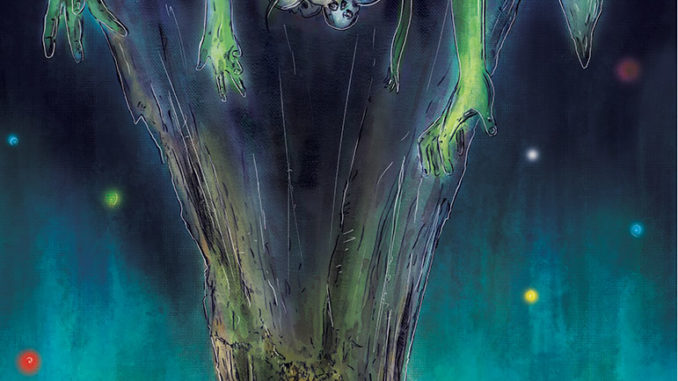
The artwork of myth, science-fiction, horror and literature intermingle in Lyndon White’s ‘H.P. Lovecraft’s The Call of Cthulhu Concertina.’ From the cover there’s an inversion of hope as a beacon of light is upside down. And the auspicious start descends from there. With no words directing the narrative, the reader must rely on the visual clues of ‘Cthulhu’ to figure out what’s happening. This works well since horror rarely needs translation. As we see a series of letters and mini-drawings (artwork within art), the pieces start coming together. Amidst the scary bits is a young man who hasn’t an idea of what he’s fallen into. Winged and hooded things, that appear to be manifestations from a fevered mind will peak your curiosity. Alongside large creatures hovering over small, torrential seascapes, primary blues amidst swirls of other colors, tells a story bordering on the fantastic. Your mind suddenly becomes flooded winged octopi and doors with hidden symbols. Is this happening underwater or is it all in your head?
As the only recognizable human in this story sleeps, the ceiling is riddled with a supernatural figure. It’s as if the small drawings in the earlier pages have come to life. Did the young man manifest them through a dreamscape or did his subconscious open a door into another dimension? Still throughout the story Lyndon White makes sure to have some form of light on each page. There always seems to be a hidden sense of hope even if some sense of sanity being lost. In part, what makes this vision of ‘Cthulhu’ a joy to read is that it avoids the racist overtones sometimes seen in Lovecraft’s work. Rather, the focus is on the hints of madness and ambiguity that tends to blur what is real from what could be imagined.
White’s other Concertina of ‘Dante’s Inferno’ is equally well done. Originally published in the fourteenth century by Dante Alighieri as the first installment of the long poem the ‘Divine Comedy’ it focuses on the original poet literally going through hell. As he’s guided by the ancient poet Virgil, there is much commentary on sin and what leads humanity to fall into moral corruption. It still holds up and in the case of this comic book, can also be seen through the lens of horror. In White’s version both Dante and Virgil are on a journey to face the devil himself. The look on Dante’s face on the cover is a mixture of dread and resignation. He’s determined to go on this journey, yet doesn’t believe his soul will remain intact. Still, as in ‘Cthulhu’ Dante has a small beacon of hope from the beginning of the tale as his pendant appears to be illuminated.
Each circle of hell is represented. As two figures freefall, as the reader you feel committed to be a part of experiencing the horrors of damnation. It is a fantastic setting where White almost makes it seem inviting. But the closer you look, the more you see the damned souls and the visual, graphic novel interpretation of what could only be imagined in the original text becomes alive. Ambiguity becomes concrete as blazing skeletons and multiple-fused faces appear. But with all the horrors and sadness, whether it be a tiny lantern in an obscure position, there’s still a lighted beacon of hope, somewhere found on every page.
Together these Concertinas will remind you of those old school anthologies of comic books as the themes of horror and fantastical beasts are highlighted. Visually stunning there’s no need for words. It’s that good.

Leave a Reply